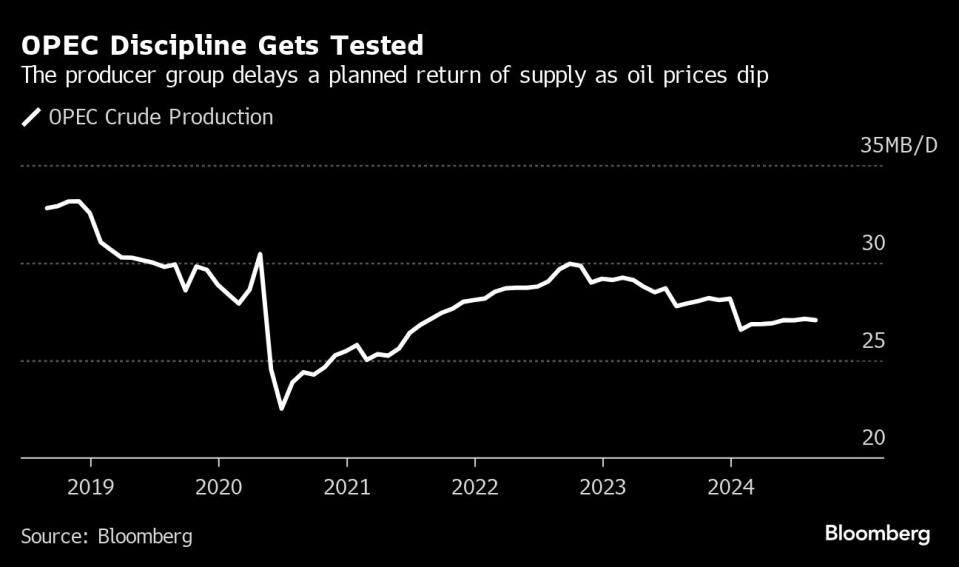Singapore’s Oil Party Spoiled by Falling Prices and China Gloom
(Bloomberg) -- The oil party isn’t over yet — but for top merchants and executives gathering for talks and rooftop cocktails in Singapore this week, the exuberance that came with the outsized profits of recent years is quickly fading.
Most Read from Bloomberg
World's Second Tallest Tower Spurs Debate About Who Needs It
The Plan for the World’s Most Ambitious Skyscraper Renovation
UC Berkeley Gives Transfer Students a Purpose-Built Home on Campus
Madrid to Ban E-Scooter Rentals, Following Lead Set in Paris
China’s economic slowdown, structural shifts in the global energy mix and the prospect of additional crude supply are all weighing on refiners and producers. Processing margins have tumbled. Traders will be no less glum, as the turbulence of the pandemic and of the months that followed Russia’s invasion of Ukraine — once-in-a-generation events — have been replaced by low volatility.
The thousands of oil executives, hedge funds and investors gathering for the Asia Pacific Petroleum Conference (APPEC) will be facing up to the grim reality that is already forcing Wall Street analysts to revise down price and demand forecasts. In recent weeks, global oil prices have erased all gains for this year. OPEC and allied nations have found themselves compelled to postpone a supply hike that could have tipped the market into surplus.
Sentiment is unquestionably bearish, said Warren Patterson, head of commodities strategy for ING Groep NV in Singapore, absent a return to the geopolitical uncertainty and trading frenzy of the years when Donald Trump was in the White House. “It would take something like Trump coming back in to shake things up again to add that kind of excitement and turbulence back into the market.”
Of all the gloomy topics at Asia’s biggest oil gathering of the year, the toughest to avoid will be China — and the question of whether cooling consumption is masking a more permanent decline in fossil fuel use as clean energy takes hold.
Beijing’s economic troubles run deep, and indicators have repeatedly sounded warnings on demand in the world’s largest crude importer, until recently a key source of growth for global crude. In August, factory activity contracted for a fourth straight month, while loan data has been uninspiring and the job market dour. Economists are now forecasting China will fall short of delivering its growth target of around 5% this year.
Traders who anticipated a stimulus-led recovery have repeatedly been forced to revise their forecasts, initially pushing the revival back to early this year and now into 2025.
Even then, China will likely face a new normal when it comes to energy. Commodities trader Trafigura is among those who have suggested the nation’s gasoline demand may have already peaked due to rapid growth in electric vehicles, while high-speed rail travel and trucks fueled by liquefied natural gas are crimping appetite for jet fuel and diesel. These, combined with a slump in consumer confidence, have already contributed to a year-on-year dip in crude imports from January-July — a phenomenon previously seen only during the depths of Covid-19.
The other cloud hanging over the Singapore gathering is Organization of the Petroleum Exporting Countries and allies and what comes next — even after the cartel brushed off Libyan outages and pushed back additional supply for two months — a move that still wasn’t enough to roll back steep price losses.
Since OPEC+ began output cuts in 2020, some of the group’s traditional suppliers have been losing ground in China, where refiners cranked up imports of restricted crude, using networks that the US cannot reach. India has turned to lesser-known entities to broker deals.
While Saudi Arabia has invested more in Chinese refiners, locking in some downstream demand, it’s unclear if that’s enough to stem a decline. A slump in margins is capping processors’ ability to pay for imports, leading operating rates at China’s private refining sector to hover at close to 50% or lower in the past weeks. State-owned processors, meanwhile, are considering trimming volumes in a counter-seasonal move.
The one irrefutable winner next week will be the city-state of Singapore. From its skyscrapers, oil executives will spot the queue of hundreds of vessels waiting off the coast for their chance to refuel, a reminder that this is one of the world’s busiest bunkering hubs, as well as a key financing center.
Since attacks from Houthi rebels in the Red Sea began last year, the port of Singapore has seen a surge in bunker fuel sales and trans-shipment activity as vessels ranging from container carriers to oil supertankers make the detour around the African continent, skipping spots such as Fujairah in favor of Southeast Asia.
The trading community that has thrived along with the port is still expanding. Even Dubai’s emergence as an attractive alternative for many companies — a financial center where firms handling Iranian and Russian trades can easily be set up and dissolved — has yet to dent the appeal of the island nation.
What may be up for uncomfortable discussion, among cocktails and presentations, is whether China’s slowdown could.
Most Read from Bloomberg Businessweek
‘They Have Stolen Our Business’: When You Leave Russia, Putin Sets the Terms
The Average American Eats 42 Pounds of Cheese a Year, and That Number Could Go Up
How Local Governments Got Hooked on One Company’s Janky Software
Howard Lutnick Emerges as Trump’s No. 1 Salesman on Wall Street
?2024 Bloomberg L.P.

